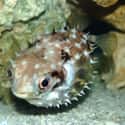-
(#1) Groups Of Male Dolphins 'Aggressively Herd' Individual Females
"Aggressive herding" is a scientific name used to describe the uncomfortable way male dolphins find their partners. When mating with females, male dolphins normally form alliances of two or three. Yet, female dolphins can be pursued by up to 13 males during a single season. While male dolphins can be attracted to a female at any given time, they are most likely to aggressively herd if the female has a calf between 2 and 2.5 years old, or if she lost a calf between one and two weeks ago.
During this mating routine, the males choose a female and relentlessly mate with her for weeks at a time. If she tries to escape, she is chased. The males will frequently beat her with their flippers to maintain dominance.
While this sounds like a form of rape to humans, it is often spoken of in scientific literature as a normal mating ritual. It is, however, an unquestionably violent mating habit and certainly goes against the "friendly dolphin" stereotypes we see in the media.
-
(#2) Wild Dolphins Have Shown Signs Of Sexual Aggression Towards Humans
Do dolphins sexually attack humans? Many videos, including one posted to YouTube by Michael Maes, have shown that swimming and diving with dolphins might not be as innocent as you'd think. Divers have seen dolphins climb on top of humans, and many even appear aroused. While these behaviors are disturbing to us, they aren't classified as "rape." Since dolphins don't understand the concept of consent like we do, their intent may not be malicious, and we can't assume why they're doing it. Yet, it's a surprisingly common behavior.
In fact, authorities have warned swimmers of sexually aggressive dolphins in certain bodies of water, including Weymouth Harbor, England. While it's unlikely that these sea creatures are trying to have full-on intercourse with humans, these events can be horrific and could lead to injury or drowning.
-
(#3) Dolphins Kill Other Newborn Dolphins
"Infanticide" is the term used when animals kill helpless newborns from their own species. It most commonly happens with animals like lions and monkeys, but dolphins are capable of it, too. In 2013, scientists observed a bottlenose dolphin give birth in the wild. What should've been a beautiful moment quickly took a dark turn.
Only two minutes after the calf was born, two males tried to drown the newborn. The mother kept trying to push the calf back to the shore, but male dolphins continued to push it down. While the researchers were too far away to spot all the details, they suspect that the males had been waiting around before the female gave birth.
These actions are rare in animals like dolphins, whales, and porpoises. Other cases have been reported though, including one where males threw the calf into the air. Yet, if these infanticides occur underwater, they could be harder to spot. Scientists believe that it happens more than we think, and it might be a way for the males to make females ready to breed again sooner.
-
(#4) Bottlenose Dolphins Attack Porpoises For Fun
Dolphins regularly eat fish, which is something most people are comfortable with. Yet, it's a bit more unsettling when they hunt animals closer to their own size. Researchers have witnessed bottlenose dolphins throwing and "attacking" porpoises. Dolphins don't eat porpoises, but they still bite them, toss them, ram into them, and sometimes even kill them.
Scientists have observed porpoise carcasses washing up on shore with scars that look like dolphin teeth marks. It's difficult to know the exact reason for these behaviors. These attacks could be related to territorial behaviors, a sense of competition, or just a fun activity. Either way, their body language displays that it's likely something dolphins enjoy doing, despite how much it scares humans.
-
(#5) Dolphins Sometimes Hunt In Massive Groups Of 1,000
Animals hunting can be intimidating enough to their prey, but imagine seeing 1,000 predators hunting at once. Many dolphins hunt in groups known as pods, but they usually range from 2 to 30 dolphins. However, video footage from the Monterey Bay Aquarium shows a group of about 1,000 dolphins hunting simultaneously. While it's difficult to see what they're hunting, a few dolphins can be seen gathering fish in their mouths.
"It's a very special sighting nearshore of one of the ocean’s magical moments often hidden away from human observation, but to the dolphins it was probably just another Monday,” said Patrick Webster, a member of Monterey Bay Aquarium’s social media team.
Scientists have nicknamed this massive gathering "a superpod." From a distance, it's a beautiful sight, but it's not a pod most people would feel comfortable swimming toward.
-
(#6) Dolphins Torture Their Food Before Eating It
While the reason can vary, dolphins love to play with their food before they eat it. This idea is cute until you remember that dolphins eat living creatures. So, you might see dolphins throwing fish, squid, and other sea creatures into the air before eating them.
The motives of this behavior depend on the situation. In many cases, dolphins torture their food as a safety precaution. Some of their prey, such as octopuses, have defense mechanisms. So, by tossing and ripping their food, it's easier for dolphins to safely consume their meals. Yet, in some instances, dolphins just like to play or show off to other dolphins.
"A lot of smaller fish that dolphins catch are swallowed quickly underwater," said Whale and Dolphin Conservation field officer Charlie Phillips. "It's only the bigger prey that we tend to see getting this sort of treatment."
-
(#7) Dolphins Use Toxic Pufferfish To Get 'High'
If you thought humans were the only creatures to abuse dangerous substances, think again. Animals like horses, elephants, and monkeys have all been reported to be drawn to toxic substances the way that humans are interested in alcohol. As it turns out, dolphins are guilty of this, too. Of course, animals don't process ideas like "drug abuse" the same way we do, but it seems to be a repeated behavior.
Dolphins have been seen playing with toxic pufferfish, passing them back and forth like a beach ball. Pufferfish release a foul, dangerous substance when threatened, so the dolphins ingest it as they play with the pufferfish. Large amounts of this toxin can be life-threatening, but small amounts only put creatures in a "trance-like state."
According to zoologist Rob Pilley, dolphins in a BBC documentary were seen mesmerized at their own reflection on the water's surface after biting a pufferfish.
-
(#8) Dolphins Don't Need Sleep To Hunt Their Prey
After pulling an all-nighter, most humans have trouble focusing the next day. However, dolphins can stay alert and aware of their surroundings even after losing several days of sleep. Dolphins can stay awake for at least five days straight without showing any health problems at all.
This bizarre behavior occurs because dolphins have two halves of their brain that can act somewhat independently of each other. One half of the brain can "shut down" at a time, allowing their brain to sleep in shifts. Essentially, it's like they're sleeping with one eye open, making them always ready to attack prey on the spot. Dolphins can also transfer information that they learned from one side of the brain to the other.
After five days without sleep, dolphins then need to rest both sides of their brains longer to make up for the sleep they missed.
-
(#9) Dolphins Commonly Carry STDs
Like many animals, dolphins usually carry sexually transmitted diseases like genital warts. When you think about it, it makes sense considering that dolphins don't know how to use protection like humans do. They don't think about the consequences of intercourse, which leads to STDs being passed frequently in the animal kingdom.
However, research suggests that some STIs in humans originally came from animals. That's yet another reason to keep your distance from wild dolphins.
"Two or three of the major STIs [in humans] have come from animals. We know, for example, that gonorrhea came from cattle to humans. Syphilis also came to humans from cattle or sheep many centuries ago, possibly sexually," said Alonso Aguire, a vet and president for conservation medicine at the Wildlife Trust.
-
(#10) The Navy Trained Dolphins To Target Human Enemies
In 1960, the Navy launched the Marine Mammal Program, which trained creatures like dolphins and beluga whales for military purposes. Most dolphin tasks included finding and marking where underwater mines were located. However, bottlenose dolphins were also trained to locate and defend themselves against enemies. Rumors circulated that the dolphins were trained to shoot enemy swimmers with a special device, but the Navy denies these accusations.
However, these dolphins were fully capable of stopping enemies from planting explosives. They would patrol the area and use a device to "tag" an enemy so humans could capture them. In 1992, there was controversy as to whether or not it was safe to release retired dolphins back into the wild since they might continue to guard and defend as they were trained to do.
-
(#11) Male Dolphins Form Homosexual Relationships To Pursue Females Better
Janet Mann, a professor of biology and psychology at Georgetown University, has closely studied bottlenose dolphins and their relationships with each other. She discovered that male dolphins spend most of their lives with each other, forming long-term relationships that differ from the ones they have with females. In fact, before mating with the opposite sex, both male and female dolphins often show homosexual behaviors toward each other. Yet, this doesn't mean they're considered homosexual creatures.
Instead, male dolphins likely have sexual relationships with other male dolphins for their own personal gain. Those behaviors help the male dolphins form closer bonds with each other. Thus, when they're ready to mate with a female, they can find her and "aggressively herd" her together, since that's a mating ritual that works best with several males involved. The homosexual behaviors of most dolphins ultimately result in offspring with the opposite sex eventually.
New Random Displays Display All By Ranking
About This Tool
Our data comes from Ranker, If you want to participate in the ranking of items displayed on this page, please click here.











